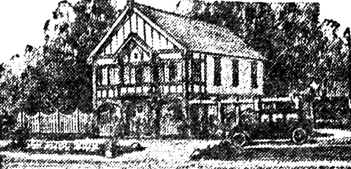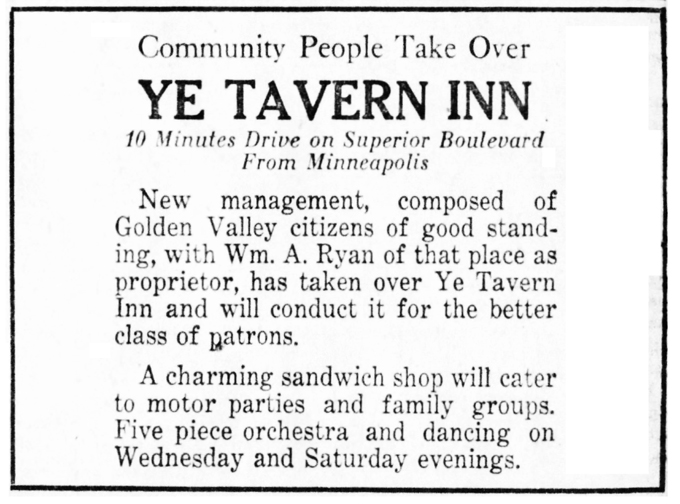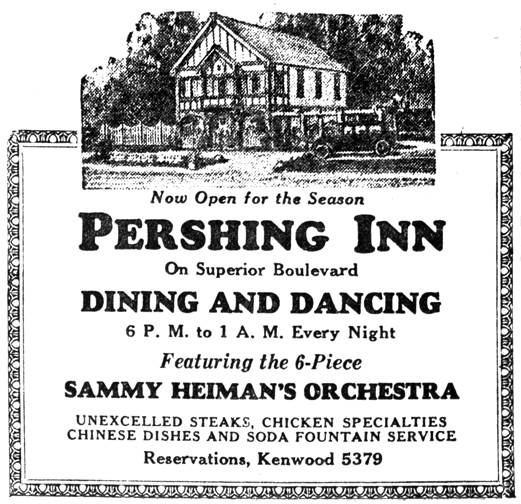Pershing Inn
This page covers three related venues:
- Ye Tavern Inn
- The Pershing Inn
- The New Pershing Inn
This building was always described as on Superior Blvd., a mile from the City Limits. The Turf Club was also a mile from the border on Highway 55, and that address was 4900, so presumably the Pershing was located at 4900 Wayzata Blvd. in Golden Valley. This would be in the NE quadrant of the Highway 394/100 intersection. The site is probably under the freeway or on an on-ramp today.

Minneapolis Daily Star, April 24, 1926
YE TAVERN INN
The first mention found of the site was in 1921, in a column by “Pollyanna” in the Minneapolis Sunday Tribune. An early gossip column, perhaps? She describes it as a “new pleasure house,” just a 15 minute drive from downtown. She lauds the excellent music, dancing, entertainment, and food. “And besides all this, There is that air of refinement and good taste which will put you at your ease.” And although Polly didn’t call it that, it had valet parking! (July 3, 1921)
In actuality it was probably an early suburban speakeasy, opening in the second year of Prohibition under the wary eye of the county sheriff.
On February 7, 1922, a “Daring Bandit Raid” took place at the Tavern, when nine young bandits, directed by a gray haired leader with two guns, held up the 75 patrons. While the older man covered the group with his guns, his helpers relieved them of diamond rings, necklaces, breast pins, small jewelry, and about $800 in cash. Then they ripped the phone from the wall, “slugged the cook and two waiters, and dashed away in a touring car without lights.” (Minneapolis Journal, May 17, 1926)
By 1924, things may have gotten out of hand. The ad below tells us that the management has changed for the better, with upstanding citizen William A. Ryan as proprietor. Clearly they wanted to throw the bums and drunks out and run a high-class speak.

Minneapolis Tribune, August 13, 1924
The following ad reiterated that only the better class of people were welcome:
Ye Tavern Inn, Superior Blvd. – The place you always wanted to go to eat. Now open. Only the better class of people invited. Dancing and good music Wednesdays and Saturdays. (Minneapolis Tribune, August 15, 1924)
PERSHING INN
By 1925 the place had changed its name to the Pershing Inn, as evidenced by a report that it had lost its roof and porch as a result of the tornado/cyclone of that year. It closed June 2 and 3 for repairs. (Minneapolis Daily Star, June 3, 1925)
On January 1, 1926, in the middle of New Year’s Eve celebrations, a fire started on the roof and the party was over when firemen from Minneapolis “invaded the building to fight the blaze.” There was only slight damage. (Minneapolis Tribune, January 2, 1926)

Minneapolis Tribune, April 17, 1926
THE PERSHING PERISHES
The Pershing building burned to the ground on Sunday afternoon, May 16, 1926. The fire broke out in the kitchen, and although the St. Louis Park fire department arrived soon after, lack of water made it impossible to fight. The fire spread quickly through the two-story frame building. By the time the Minneapolis fire department arrived with chemical equipment, the building was a “mass of flames.”
In those days when entertainment was at a premium, fires brought spectators from miles around, further foiling the efforts to douse the flames. People driving to “the lakes” (west to Minnetonka? East to Minneapolis?) stopped to watch, lining the road with cars. Motorists and firemen formed a bucket brigade to save adjoining buildings. Several patrons were in the Inn at the time the flames broke out, but no one was injured. (Minneapolis Tribune, May 17, 1926)
The next day, all that remained was a lone chimney was all that was left. It was revealed that the Inn had been managed by Artis Boettcher and Benjamin Blindman. Damage was estimated at $15,000. (Minneapolis Journal, May 17, 1926) The company that owned the business was declared bankrupt on June 18, 1926.
THE NEW PERSHING INN
Although quite a distance from the original Pershing, a “New Pershing Inn” opened in White Bear Lake on December 3, 1927. It is unclear whether this venue is related to the Pershing Inn in Golden Valley. It was in the building better know as the Plantation Nite Club, and only lasted for a month or so.
